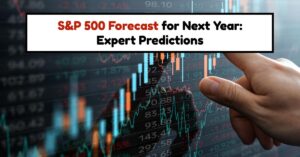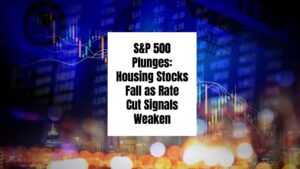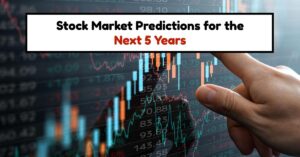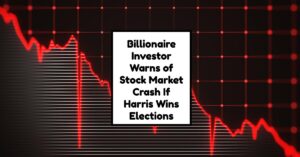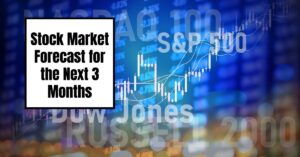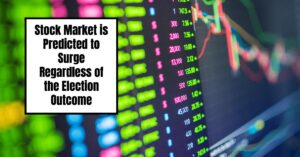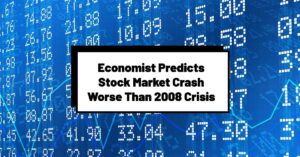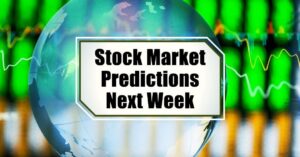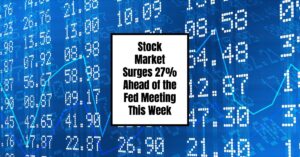
The stock market has surged by an extraordinary 27% year-to-date, marking one of its most remarkable annual gains in decades ahead of the Federal Reserve's final meeting of 2024, scheduled for December 18th. This surge is tied to growing optimism about a possible interest rate cut, robust performance in the technology sector, and steady (albeit mixed) economic indicators. However, as the meeting approaches, renewed volatility underscores the delicate balancing act faced by both investors and policymakers alike.
The Stock Market Surge: 27% Increase Ahead of the Fed Meeting
Key Takeaways
- 27% surge in 2024: The S&P 500 and other major indices are soaring as investor confidence hits record highs.
- Fed policy outlook critical: Markets are heavily focused on a possible 25 basis point interest rate cut during the upcoming Federal Reserve meeting.
- Tech giants lead growth: Companies in artificial intelligence (AI) like Broadcom and NVIDIA have fueled growth with stellar performances.
- Economic signs mixed: Consumer spending and corporate investment are showing signs of stability despite persistent inflation concerns.
- Volatility looms ahead: Investor sentiment remains jittery as the Fed decision nears, raising the potential for sudden market shifts.
What Has Driven the Stock Market’s 27% Explosion in 2024?
1. The Federal Reserve’s Role and Rate Cut Speculation
All eyes are now on the Federal Reserve, which has completed one of its most aggressive monetary tightening cycles in recent U.S. history to tame inflation. After a 2021-2023 period rife with rate increases, inflationary pressures are finally showing signs of abatement. Multiple financial commentators, including those from Morningstar, predict the Fed will ease rates with a 0.25% (25 basis point) cut during its December meeting.
Here’s why this is key to the market surge:
- Lower interest rates typically translate to lower borrowing costs for businesses, which helps support corporate earnings.
- Investors immediately bid up stock prices in anticipation of a business-friendly monetary landscape supported by a dovish Federal Reserve.
It’s worth noting that market expectations hinge not simply on the rate cut but on signals about future policy. Chair Jerome Powell’s post-meeting remarks will receive intense scrutiny as they may shape broader market behavior heading into 2025.
2. A Historic Year for Technology Stocks
Technology has led the bull charge across markets, with AI-focused firms dominating headlines. Stocks like Broadcom, propelled by high demand for artificial intelligence systems, have hit unprecedented year-over-year returns (NVIDIA financial results).
Major drivers for tech success this year include:
- Artificial Intelligence Expansion: AI-related products have become indispensable, expanding in both enterprise solutions and consumer tech. Whether powering autonomous systems or revolutionizing cloud networks, AI played a dominant role in uplifting tech indices.
- Record Corporate Guidance Success: Key firms exceeded Wall Street’s earnings expectations consistently this year, backing their lofty valuations with tangible growth outlooks.
In broad strokes—when tech thrives, so do modern stock indices like the Nasdaq and S&P 500, given their overweight dependence on mega-cap tech stocks. The AI boom seemed to serve as the driving engine behind this year's extraordinary gains.
3. Unexpectedly Resilient Economic Data
While inflation remains an enduring issue, several economic indicators signal stabilization rather than trouble. In particular:
- Slowing Inflation: Though not completely under control, inflationary pressures have eased compared to prior years.
- Corporate Investment Growth: Businesses are still spending on expansion, particularly in booming sectors like technology and renewable energy.
- Consumer Spending: The foundation of U.S. economic strength—consumer demand—has been steadfast in the face of price hikes.
Experts from Reuters believe the interplay of lower inflation and steady economic activity suggests that markets are pricing in “mild optimism” about continued growth in 2025.
The Mixed Bag of Market Performance Leading to December
While the S&P 500’s 27% return stands tall, a closer examination reveals pockets of unease:
- The Dow Jones Industrial Average (DJIA) faltered in early December by recording its worst losing streak since 2020, signaling skepticism among more traditional stock segments (Economic Times).
- Even Nasdaq’s performance has shown hesitation in the week leading into the final Fed meeting, spurred on by last-minute fears of unexpected inflationary data.
This mixed performance illustrates how sensitive current markets are to headlines and government decisions.
What’s Next?
There are two distinct scenarios at play here:
- The Fed Affirms Rate Cuts Going into 2025: Such an announcement would amplify the ongoing bull run while also increasing speculative rally potential, especially in growth-centric industries like tech.
- Fed Opts for ‘Wait-and-See’: Even modest hesitancy from Powell and the Federal Reserve might spark short-term volatility across the board—profit-taking actions are a notorious risk anytime markets hit historic highs.
It’s also worth keeping an eye on broader macroeconomic-styled indicators (like manufacturing productivity or oil pricing)—subtle signals in these areas often feed investor sentiment indirectly.
Final Thoughts: The Importance of Monetary Policy Clarity
With such a strong year on record, the stock market has capitalized on optimism spearheaded by promising corporate reports and favorable economic shifts. However, all gains remain precariously sensitive to uncertainties about the Federal Reserve’s next steps. This year proved that tech firms (boosted by the thriving AI economy) were pivotal in shouldering the surge.
Partner with Norada, Your Trusted Source for Turnkey Investment Properties
Discover high-quality, ready-to-rent properties designed to deliver consistent returns. Contact us today to expand your real estate portfolio with confidence.
Reach out to our investment counselors:
(949) 218-6668 | (800) 611-3060
Recommended Read:
- S&P 500 Plunges: Housing Stocks Fall as Rate Cut Signals Weaken
- S&P 500 Forecast for the Next Year: What to Expect in 2025?
- Stock Market Predictions for the Next 5 Years
- Billionaire Warns of Stock Market Crash If Harris Wins Elections
- Stock Market is Predicted to Surge Regardless of the Election Outcome
- Echoes of 1987: Is Today’s Stock Market Crash Leading to a Recession?
- Is the Bull Market Over? What History Says About the Stock Market Crash
- Wall Street Bear Predicts a Historic Stock Market Crash Like 1929
- Economist Predicts Stock Market Crash Worse Than 2008 Crisis
- Stock Market Forecast Next 6 Months
- Next Stock Market Crash Prediction: Is a Crash Coming Soon?
- 65% Stock Market Crash: Top Economists Share Scary Predictions for 2024
- Stock Market Crash: 30% Correction Predicted by Top Forecaster
